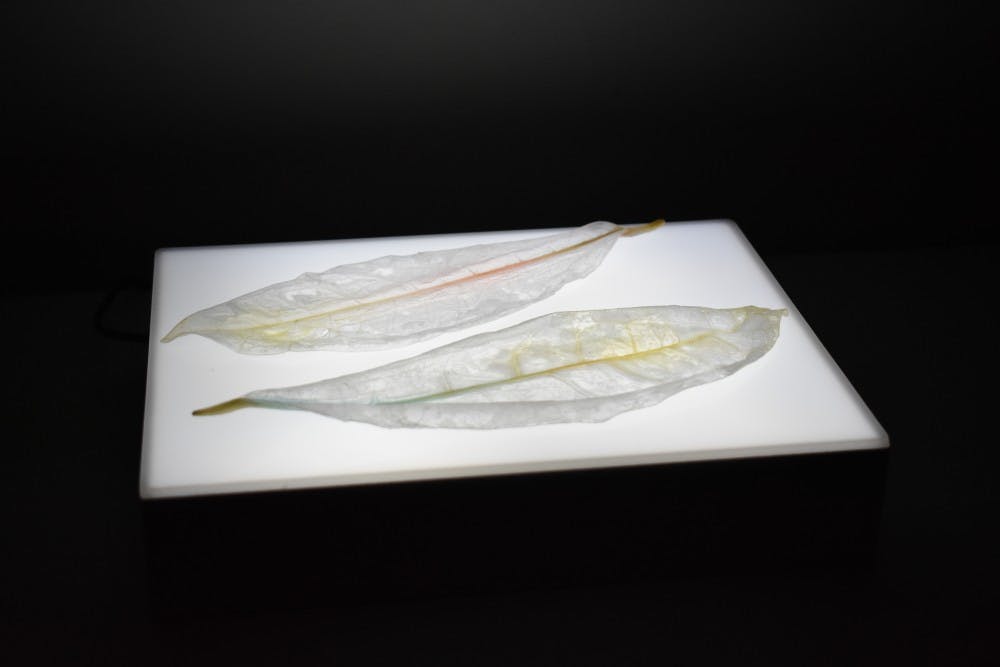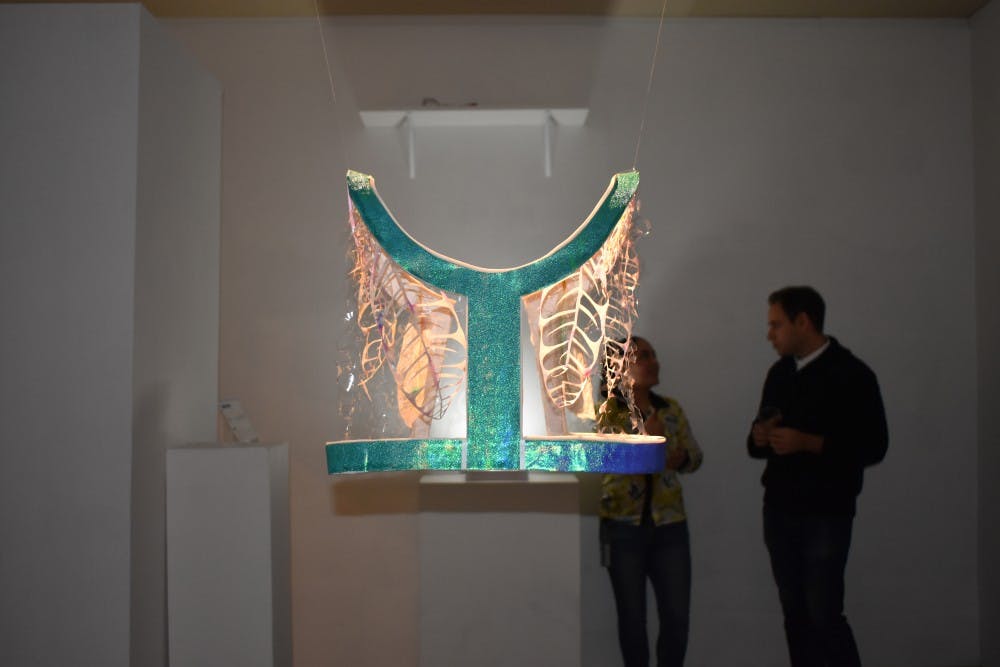At the corner of 36th and Market, the Esther Klein Gallery, a gallery exploring the connections between art, science, and technology, hosted a display of life. Not in a metaphorical sense, but in the most literal one. A jar of mealworms, a petri dish of cultured bacteria, and a vest–like garment of microbes from the mouth—the gallery was teeming with life. On December 5, students from the class “Integrative Design Studio: Biological Design” exhibited their final projects in a live showcase of the intersection of art and biology
The room is white, dimly lit, but with each piece under a yellowed spotlight. At the very front is a table of what appears to be a gourmet meal from most definitely a three–dollar–sign, if not four, restaurant. A steak sits atop a white dish, plated much like the dishes concocted by the Masterchef finalists (a sight I know almost too well from the episodes I’ve devoured) and flanked by a glass of wine and a menu in cursive writing that is only indicative of its high–flavor. Right beside it is a jar of what, to me, at first glance, is maybe cocoa powder; it seems only fitting for something of that sort to sit next to a steak. But looking closer, it’s dirt. A jar filled to its brim with dirt and mealworms.

Across from this is a black table with four gloves sitting on top. Beside are two serum dispensers and a small container of white cream. Interesting. The artist Alina Peng (C ‘20) tells me it’s actually a cream to restore the skin, mixing a certain bacteria with glycerol. Putting it on my hand, I can attest to its truth (though to be fair, it’s probably pseudo) The project is an investigation of the effects of arthritis and cirrhosis. Using research on the mechanics of an octopus's muscular hydrostat system, which allows them to move through water, the gloves are designed to mimic these systems in hopes of devising a solution to these medical problems. One, made of silicone; another, also by silicone, but injected by micro tubing gel.
Further down is the work of Nathaniel Nyema (E ‘20), whose piece centers around the word “Kamili,” which means “exact,” “perfect,” and “complete” in Swahili. It’s an exploration of an Africa that would’ve been had it not been for colonization due to the mastery of synthetic biology. For example, in the sixth century, the Nubian people would drink beer fermented by a certain bacteria, a bacteria that would later allow them to resist the onslaught of the Justinian plague that claimed the lives of 25–50 million people.
On a pedestal lies objects that reimagines objects existing today if Africa had not been colonized: a mask, a drum, a headscarf, and capsules of cells. The mask holds bacteria engineered to hold DNA and genetic information that can be used to uncover family history, another product of synthetic biology in understanding the history and future of Africa. “I wanted to introduce something related to the future of Africanism and to explore synthetic biology in an Afro–futurist world,” said Nathaniel. “It’s interesting to see that everything started with this mask that incorporates synthetic biology.”

Just as Nathaniel did, the drawing of roots and history is something Natalia Cabalceta (C ‘20) shows off in her piece. “The inspiration came from questions after my grandmother died a month and a half ago,” Natalia explained. “What does it mean that those microbes [shared between her and her grandmother] are not there?” Taking swabs from her skin and mouth, Natalia cultivated the microbes and harvested them on four leaves. The objective was to translate them into a wearable, with two of the leaves resting on a vest-like garment. It’s keeping people close—whether deceased or not—to a whole other level.
The technique of harvesting bacteria was similarly implemented by Ryan Lee (C ‘22). Eight petri dishes stick to the wall, with the material forming a map of the world below. In making this, Ryan had reached out to 8 people from around the world to collect their mouth swabs. Identifying similarities across all the samples, he then took the similarities to form a map of the world to “symbolize how on a cellular level, we all share similar traits,” Ryan described. “That [the idea of identity being affected by appearance] really resonated in me because the world is going through the same thing and how based on the appearance, we’re all treated differently.”

While the exhibit and pieces are no longer at the Esther Klein (given that some may have actually died by the time you’re reading this), the underlying idea stands. In these concepts of biodesign, these student artists have pioneered a new language in describing life, one that mixes biology and art.
A previous version of this article misspelled the name of Natalia Cabalceta (C'20). It stated her last name as "Calvalceta" instead of "Cabalceta". 34th Street regrets the error.

